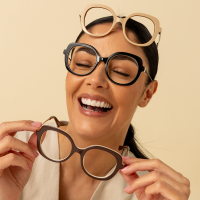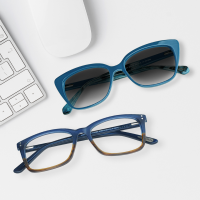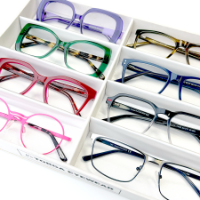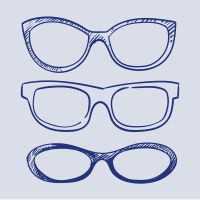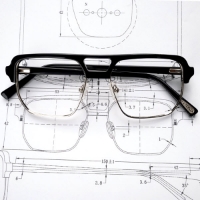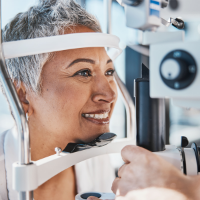Lens Technology For Over 40s
Everything you need to know about Your Vision Over 40
Monday, 4 June 2018
In a world that is obsessed with eternal youth, efficiency and massive workloads, the inevitable deterioration of one’s eye sight at a certain age - *gulp* yes, forty – is a daunting prospect for many!
The good news is that with huge strides in technology comes fantastic advances in lenses and eyewear. In addition to having a plethora of fashion frames from which to choose, lens technology has progressed to a point where the tell-tale signs of ageing eyes (read: those bifocal half-moon lenses) have, thankfully become an almost-distant memory).
The bad news is that no one (yes, sorry, no one!) escapes ageing – everyone’s eyes deteriorate with age. It’s inevitable. It will happen to you. So, if you are having difficulty focussing on that really ridiculously, tiny text on your cell phone, or if your arms just don’t seem long enough when you’re studying that sushi menu, then it’s probably time for a visit to your optometrist.
To ease the pain, we’re going to explain various eye terms and visual conditions, along with potential solutions, so that you will be empowered to make an informed decision when the need for spectacles arises.
What happens to your eyes as you get older?
As the eye ages (i.e. as one nears the age of forty), the muscles that enable the ocular lens to work become weaker. The result is that the focusing ability for near vision becomes more difficult and eventually not possible. This condition is called presbyopia. The youthful flexibility of the lens and the respective muscles allow the eye to change focus from objects that are far away to objects that are close.
Solution:
Eyeglasses, including single vision reading glasses, bifocals and multifocal lenses address presbyopia very effectively.
Multifocal (also known as progressive and varifocal) lenses give you a more youthful appearance by eliminating the visible lines found in bifocal lenses and allow you to focus clearly at varying distances. Bifocal and single vision lenses don’t give you the clear vision at all distances - reading glasses have one focal point and bifocals allow for clear distance and near vision but they aren’t great for intermediate distances, such as computer work.
What's the difference between presbyopia and hyperopia?
Farsightedness, or hyperopia, occurs when light focuses behind the retina instead of on it due to a shorter than average eyeball. People of any age, including babies, can be farsighted. Presbyopia, on the other hand, is an age-related condition in which the lens and muscles of the eye becomes less flexible. You can therefore be both hyperopic and presbyopic over the age of 40.
What is a multifocal lens?
Multifocal optical lenses transition from your distance prescription at the top of the lens to your reading prescription at the bottom of the lens to help you see objects at all distances after you lose the ability to naturally change the focus of your eyes due to age (presbyopia). All Torga Optical multifocal lenses are manufactured using highly sophisticated digital software and German precision lens technology.
What is the difference between a bifocal and a multifocal lens?
Like bifocal lenses, multifocal lenses enable the user to see clearly at different distance ranges through one lens. A multifocal lens (AKA progressive lens) gradually changes power from the top of the lens to the bottom, giving a smooth transition from distance vision (across the room) to intermediate vision (computer, for example) to near (reading) vision. On the other hand, a bifocal only has two main focal points - one for distance vision and one for reading. These, therefore, don’t give the wearer clear intermediate vision – so they aren’t ideal for computer users.
How does a multifocal lens work?
Instead of providing just two lens powers like bifocals (or three, like trifocals), multifocal lenses really are multi-focal lenses, providing a smooth, seamless progression of many lens powers for clear vision across the room, up close and at all distances in between. One is able to see clearly here (close up), there (middle distance) and effortlessly through to the far distance (over there).
Are multifocal lenses good for your eyes?
Yes! Multifocal lenses are often the most effective way to assist those with presbyopia. They alleviate the burden that is placed on your eyes when straining to focus at different distances.
What is the difference between single vision and multifocal lenses?
Having single vision glasses means the lenses offer just one focus for the eyes. This can be for long distances correction, for close-up reading, or for mid-range sight correction, such as for computer use. Progressive lenses, on the other hand, offer a range of vision correction within the same lens.
Are multifocal lenses the best solution?
In addition to cosmetic advantages, progressive multifocal lenses provide a more natural correction of presbyopia than bifocal or trifocal prescription lenses.
We advise that you have a in depth conversation with your optometrist about your lifestyle in addition to your visual needs (once you’ve had a full eye test). Explain to him or her when your eyes are at their most strained. Go into detail about the kind of work that you do, which digital devices you use and how often. Your hobbies and how you spend your spare time is also important to consider when finding a solution to your visual needs. It’s this kind of information together with the actual eye examination that contributes to you finding the best optical correction for your visual comfort.
Click here to make an appointment online at your nearest Torga Optical.
***Disclaimer***
Always get professional advice from your optometrist.
The above article was written with professional consultation from Claire Wiggill (BOptom (UJ)).



